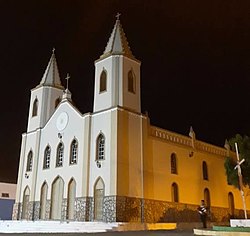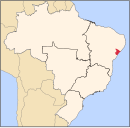Cedro de São João
Cedro de São João | |
|---|---|
Municipality | |
 São João Batista Church | |
| Motto(s): | |
 | |
| Country | Brazil |
| State | Sergipe |
| Founded | October 4, 1928 |
| Named for | John the Baptist |
| Government | |
| • Mayor | Neudo Alves (UNIÃO) |
| Area | |
• Total | 83.711 km2 (32.321 sq mi) |
| Population (2022[1]) | |
• Total | 5,391 |
| • Density | 64/km2 (170/sq mi) |
| Demonym | Cedrense |
| Time zone | UTC−3 (BRT) |
| Postal code | 49930-000 |
| Area code | +55 79 |
| HDI (2010) | 0.623 – medium[1] |
10°15′07″S 36°53′02″W / 10.25194°S 36.88389°W Cedro de São João is a municipality located in the Brazilian state of Sergipe. Its population was 5,391 (2022) and its area is about 84 km².[1] The municipality is the largest producer of carne-de-sol in Sergipe and stands out in cross-stitch embroidery.
History
[edit]Cedro de São João was formed by romanis who came from Minas Gerais. After crossing Bahia and arriving in Sergipe, a small group separated and went to live in Capela, selling products from the Japaratuba Valley (sugar and honey) and the São Francisco Valley (rice, animals and fish).
The group used to buy animals from the Cemitério farm (today Aquidabã), and with these animals they settled in a place where today is the Jonas Trindade square, in Cedro de São João. When the São Francisco River flooded, the land surrounded by the waters formed almost an island. Since it was a safe place, the leader of the group, Antônio Nunes, built a corral with cedar wood abundant in the region (the tree that gave the municipality its name in Portuguese). In 1834 there were twenty mud houses built for the vaqueiros.
By Provincial Law of March 5, 1835, the owner of the farm, Antônio Nunes, created a school, which was later closed, and which reopened on July 9, 1872, under the direction of Carolina Leopoldina Regina de Sá. The construction of the chapel of São João Batista, the current main church, made the village independent from the Propriá parish of Santo Antônio.
In 1894, an organization was created to politically separate Cedro from Propriá. Three engenhos were established in the Jacaré Valley: Imbira, owned by Antônio Santana; Poço dos Bois, owned by Antônio Soares; and Lagoa Seca, owned by Antônio Baptista Nascimento, that contributed to the formation of the economic structure. The State Law No. 83, of October 23, 1894, elevated the village to the category of municipality.
On October 29, 1901, Cedro returned to the status of a village, by Law No. 422. Shortly after, a movement for the restoration of the municipality began, with the main leaders being Antônio Batista do Nascimento, João de Deus da Rocha, Manoel da Rocha and Antônio Santana.
The Law No. 1,015 of October 4, 1928, sanctioned by Sergipe Governor Manuel Correia Dantas, elevated Cedro to the category of municipality, separating it from Propriá, with the law coming into effect on January 1, 1929. By Decree-Law No. 533 of December 7, 1944, the municipality was renamed from "Cedro" to "Darcilena" because Mayor Miguel Seixas wanted to honor the First Lady of Brazil/Getúlio Vargas' wife, Darci Vargas, and the First Lady of Sergipe/Augusto Maynard Gomes' wife, Helena. It was changed to "Cedro de São João" on February 6, 1954, by State Law No. 554, and the village of São Francisco was incorporated into the area of the municipality. Later, in 1963, São Francisco was emancipated and became a municipality.
Currently, the villages of Bananeiras, Lagoa Nova, Poço dos Bois and São Sebastião (Carvãozinho) are part of the municipality. In the past, it had other villages that were transferred to São Francisco (Piçarreira) or abandoned, as was the cases of Cruzes, Cajueiros and Batinga, the latter had a railway station with the same name, but after the closure of the RFFSA railway lines, Batinga fell into decline.[2][3]
See also
[edit]References
[edit]- ^ a b c "IBGE 2022" (in Portuguese). Retrieved 3 August 2024.
- ^ Guilherme Teles, graduated in History from Universidade Tiradentes (Unit/SE). Member of the GEM/GPCIR research group of the History Department of the Universidade Federal de Sergipe (UFS) - "História do Municipio" (in Portuguese). Retrieved 3 August 2024.
- ^ Ralph Mennucci Giesbrecht - "Batinga" (in Portuguese). Retrieved 3 August 2024.



